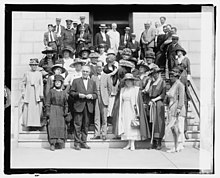Helen Hoy Greeley
[8] By 1908 the League's membership included Hoy, Charlotte Perkins Gilman, Florence Kelley, Leonora O'Reilly, Lavinia Dock, Jessie Ashley, Gertrud Barnum, Inez Milholland, and Rose Schneiderman.
[9] After the sixtieth anniversary celebration of the Seneca Falls Convention, Hoy joined a "trolley car campaign" organized by Blatch and Maud Malone, traveling throughout New York and ending near Vassar College.
[4] Hoy marched in the first New York suffrage parade, and is credited with beginning the practice of "intensive district street speaking, demonstrating its effectiveness by speaking 56 consecutive nights on one street corner, Ninety-sixth Street and Broadway"[4] In 1911 Greeley traveled throughout Sonoma, San Francisco and much of southeast California to help convince voters in previously anti-suffrage areas to support California suffrage][11][9][12][13] Greeley joined Gail Laughlin, Maud Younger, Jeannette Rankin, Margaret Haley, Alma Lafferty and other politicians and labor and suffrage activists from across the country to support the efforts in Northern California.
[15] In the final days of the California campaign, Greeley is credited with keeping an outdoor audience of 4,000 in good humor, while 6,000 others attended a mass meeting inside the Dreamland Rink.
[16][17][4] Greeley engaged in frequent presentations to gatherings of the Portland Equal Suffrage League, especially challenging President Roosevelt's statements and views on woman suffrage and his claims that women were not serious about the movement[18] In 1913 Greeley created the "Rainbow Campaign," as suffragists promoting the 1915 state vote distributed five different colored flyers to homes in New York.
Handicapped and delayed in their work by lack of authority... the army nurses here and abroad are backing a movement to obtain relative military rank.” She insisted the urgency was based on both hospital morale, respect, and efficiency of job performance (The Evening Independent June 20, 1918)”[19] Over time, viewed as a peer to M. Adelaide Nutting, Frances Payne Bolton and Annie W. Goodrich, Greeley was regarded as one of the most prominent activists seeking greater recognition and respect for the work of army nurses.
[22] On June 4, 1920, President Wilson signed into law the official army reorganization that provided nurses with military rank and the same social rights and privileges of other officers, but did not confer them with equal pay.
[24] Greeley's civic engagement in New York included leadership in the City Improvement Society, the Committee of Fifty for the Removing of the Eleventh Avenue railroad tracks, and the Women's Municipal League.
[4] Her activism related to peace and justice included word addressing amnesty for political prisoners and the need for disarmament, and activist and legal service to the NY Council for the Limitation of Armaments, the Women's Committee for World Disarmament, the Legislative Committee for the Women's International League of Peace and Freedom, and the Institute of Politics at Williams College.
